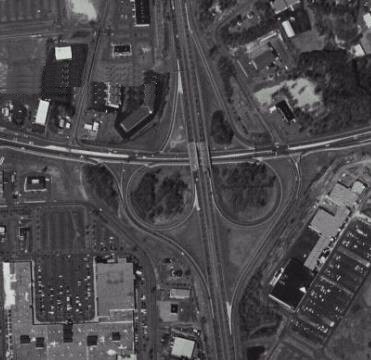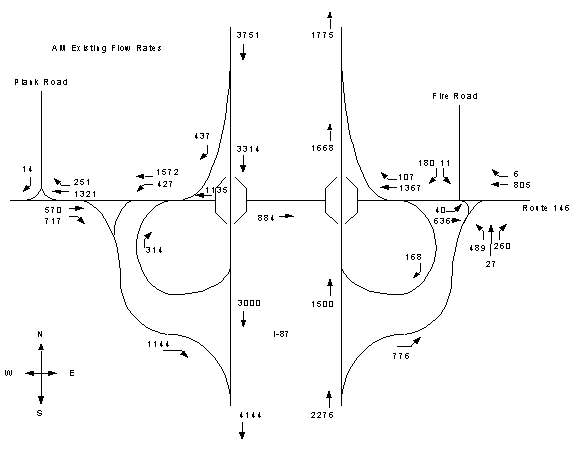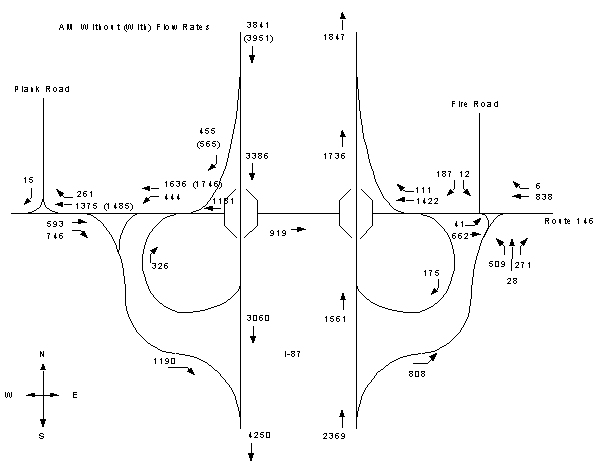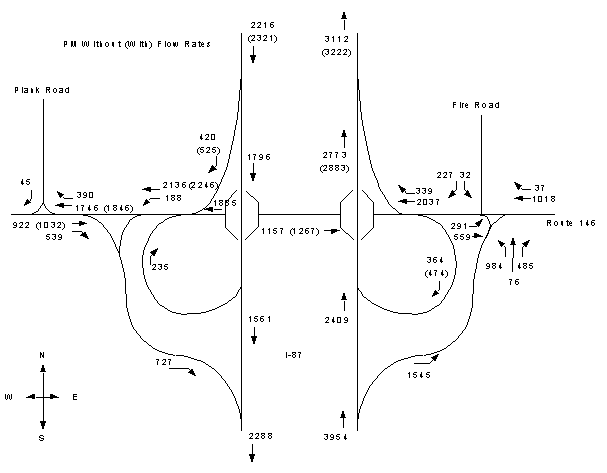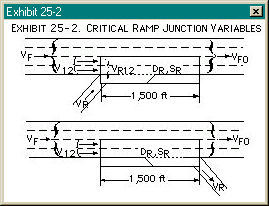
Problem 5: Interstate 87 Interchange The I-87 interchange is labeled Intersection E in Exhibit 2-1. An aerial photograph of the facility is shown in Exhibit 2-47. The interchange is a partial cloverleaf with three on-ramps and three off-ramps. Southbound, there is a single-lane off-ramp (direct) leading to Route 146 west, a single-lane off-ramp (loop ramp) leading to Route 146 east, and a double-lane on-ramp (semi-direct) for both westbound and eastbound traffic on Route 146. About a quarter of the way along the ramp, traffic from Route 146 westbound joins traffic from Route 146 eastbound to form a two-lane ramp that reduces to a single lane ramp before merging with I-87. In the northbound direction, there is a double-lane off-ramp. It expands to a triple-lane ramp then becomes four approach lanes (two leading westbound and two leading eastbound) at Intersection F. (Exhibit 2-48 is a schematic of the intersection.) There is a single lane on-ramp (loop) from Route 146 eastbound and a single lane on-ramp (direct) from Route 146 westbound. In the picture the entrance to this latter ramp is just west of Intersection F. The volumes at the interchange are shown for the AM Existing (Exhibit 2-49), AM Without and With (Exhibit 2-50), PM Existing (Exhibit 2-51), and PM Without and With (Exhibit 2-52) conditions respectively. Analysis Plans: Description of Analyses Sub-problem 5a: Merges and Diverges on the Freeway
Sub-problem 5b:
Sub-problem 5c: |
Page Break
|
Exhibit 2-48. Schematic of the Fire Road Intersection
|
Page Break
|
Exhibit 2-49. I-87 Interchange AM Existing Volumes
|
Page Break
|
Exhibit 2-50. I-87 Interchange AM Without and With Condition Volumes
|
Page Break
|
Exhibit 2-51. I-87 Interchange PM Existing Volumes
|
Page Break
|
Exhibit 2-52. I-87 Interchange PM Without and With Condition Volumes
|
Page Break
Problem 5: Interstate 87 Interchange
Analysis
Plans Unlike the previous problems, we will look at the performance of specific locations in the interchange across multiple conditions. For example, we will look at the southbound merge at the end of the southbound on-ramp and see how its performance varies between the existing, without, and with conditions. In all, we will look at nine locations: the six merge/diverge points on the freeway, the weaving section on the arterial between the loop ramps, and two junctions (the end of the southbound-to-westbound off-ramp and the left turn into the southbound on-ramp). We will look at the merge and diverge locations, the weaving section on Route 146, and the three junctions. Analyses in this problem: Southbound-to-Westbound Off-Ramp Southbound-to-Eastbound Off-Ramp Eastbound-to-Northbound On-Ramp Westbound-to-Northbound On-Ramp to Sub-problem 5a |
Page Break
Sub-problem 5a: I-87 Interchange - Merges and Diverges on the FreewayMerging and diverging points on the freeway are always important places to study in terms of capacity and performance. They’re also confusing spots to study because several ramp combinations must be examined (involving upstream and/or downstream ramps) to get an accurate sense of how the ramp is performing or will perform. Having entered information for the subject ramp and the upstream ramp does not mean that both have been studied. If two ramps are close to one another in a given location (here there are three), each must be examined to reach closure. You can study the upstream ramp first, entering the information about the downstream ramp as required; then study the downstream ramp, entering the information about the upstream ramp as required. In this case you need to study the middle ramp two ways, first treating it as a subject ramp with an upstream influencing ramp, then as a subject ramp with an influencing downstream ramp. The analysis result that predicts the worse ramp performance is the one to report. The level of service measure at a ramp junction is the density of vehicles within the ramp influence area. As shown in Exhibit 2-53, this is an imaginary box encompassing the ramp and the two lanes closest to the ramp. This is the area at the merge or diverge location that is most congested or most affected by the presence of the merge or diverge. Here the freeway speeds will be the slowest and the amount of turbulence the greatest. The inputs you have to provide are the freeway volume upstream of the merge, the number of lanes on the freeway, the freeway free-flow speed, the volume on the ramp, whether the ramp is on the right-hand or left-hand side, the free-flow speed on the ramp, the length of the deceleration lane (or lengths if there are two lanes), the volume on the upstream or downstream ramp (if there is one), the location of that ramp (upstream or downstream), and the volume on that ramp. You also have to indicate the peak hour factor, percent trucks and percent RV’s for all three volumes. We will look at the six ramps starting upper left and moving counter clockwise: the southbound-to-westbound off-ramp, the southbound-to-eastbound loop ramp, the southbound on-ramp, the northbound off-ramp, the eastbound-to-northbound loop ramp, then the westbound-to-northbound on-ramp. with Sub-problem 5a |
Page Break
|
Exhibit 2-53. Influence Area
|
Page Break
Sub-problem 5a: I-87 Interchange - Merges and Diverges on the FreewaySouthbound-to-Westbound
Off-Ramp Exhibit 2-54 shows how the ramp’s performance varies by case. You can click here to see the datasets. The LOS is always C, but the density within the influence area increases from 23.2 to 24.6 vehicles per lane per mile. The adjacent ramp is the downstream southbound-to-eastbound off-ramp.
with Sub-problem 5a |
||||||||||||||||||||||
Page Break
Sub-problem 5a: I-87 Interchange - Merges and Diverges on the Freeway
Southbound-to-Eastbound
Off-Ramp
with Sub-problem 5a |
||||||||||||||||||
Page Break
Sub-problem 5a: I-87 Interchange - Merges and Diverges on the FreewaySouthbound On-Ramp So far, we have studied single lane ramps with single lane upstream or downstream on- or off-ramps. The northbound off-ramp is a bit more complex. It has a two-lane ramp, so you have to provide a bit more input. It’s also useful to see if the two lanes are necessary.
with Sub-problem 5a |
||||||||||||||||||
Page Break
Sub-problem 5a: I-87 Interchange - Merges and Diverges on the Freeway
Northbound
Off-Ramp
with Sub-problem 5a |
||||||||||||||||||||||||||||||||||||||||||
Page Break
Sub-problem 5a: I-87 Interchange - Merges and Diverges on the FreewayEastbound-to-Northbound
On-Ramp
with Sub-problem 5a |
||||||||||||||||||||||
Page Break
Sub-problem 5a: I-87 Interchange - Merges and Diverges on the FreewayWestbound-to-Northbound
On-Ramp The conclusion we draw from these analyses is that none of the ramps is problematic, at least as far as the freeway merge and diverge points are concerned. We’ll see later that there are problems elsewhere.
to Sub-problem 5b |
||||||||||||||||||||||
Page Break
Sub-problem 5b: I-87 Interchange: Route 146 Weaving SectionBetween the southbound-to-eastbound off-ramp and the eastbound-to-northbound on-ramp there is a short weaving section. All of the traffic leaving the off-ramp heads east on Route 146, while all of the traffic for the on-ramp comes from Route 146 to the west. Weaving sections can occur on freeways and on arterials. This is one example. The HCM methodology for analyzing weaves makes provision for considering weaves on arterials. In the context of the HCM, the inputs you need to provide are: the type of weave (A, B, or C); the length of the weaving section; the free-flow speed; the terrain; and the four weaving volumes and characteristics of those volumes like the peak hour factor, the percent trucks, and the percent recreational vehicles. The LOS performance measures are the density within the weaving section (passenger cars per mile per lane) and the weaving speed. The density determines the level of service.
Exhibit 2-60 shows the performance of the Route 146 weaving section under a variety of conditions. The density ranges from 14.69 to 26.43 pcpmpl and the speed ranges from 41.74 to 43.95 mph. The LOS is either B or C. In the PM Peak, we move from low B to high C as we progress from PM Existing to PM Without conditions and the PM With conditions are just slightly worse. You can click here to see the datasets that produced these results. To study the terminus of the southbound-to-eastbound off-ramp as an unsignalized intersection, we looked at the PM With condition (Dataset 65). Exhibit 2-61 shows that we found. If we stick to the 6.2 second critical gap that’s assumed for typical right turns, we get LOS D, a delay of 31.7 seconds, and a 95th-percentile queue of 4.56 vehicles. This is inconsistent with the conditions we see today. The critical gap used by the drivers at this location must be much shorter. We looked at what would happen if we assumed a much shorter gap, like the 4.1 seconds assumed for left turns from the major street. The delay then becomes 15 seconds and the LOS is B. There’s a need to be accurate about the critical gap value being used at this location. We think 4.1 seconds is more realistic than 6.2 seconds. |
||||||||||||||||||||||||||||||||||||||||||||||||||||||||||
Page Break
Sub-problem 5: I-87 Interchange - Stop and Yield Controlled JunctionsThere are several stop and yield controlled junctions in the interchange. We have looked at one of them, the terminus of the southbound-to-eastbound loop ramp. Two more are the terminus of the southbound-to-westbound off-ramp and the left turn on Route 146 that is the westbound entrance to the southbound on-ramp. We’re going to look at those two locations to see what their performance is under the various operational conditions.We're going to do two analyses using the same approach to show what might happen and what you might find: Southbound-to-Westbound Off-Ramp with Sub-problem 5c |
Page Break
Sub-problem 5: I-87 Interchange - Stop and Yield Controlled Junctions
Southbound-to-Westbound
Off-Ramp The ramp is busy enough that there is a constant queue during the PM peak. The ramp is at or just beyond capacity. The AM peak is also busy, but a constant queue does not form. We can model this ramp as an unsignalized intersection. It is a single lane right turn onto a four-lane arterial. Exhibit 2-62 shows the predicted performance of the ramp under the AM and PM peak hour conditions (Datasets 66-73). The ramp is heavily loaded during both time periods. We adjusted the critical gap downward from 6.2 seconds, which is the default, to 5.3 seconds, to get a PM Peak hour performance that matched the queue length observed in the field. All of the analyses (except the modified ones) were done with that value. The predicted AM peak delays range from 29.6 to 74.3 seconds and the PM peaks range from 86.4 to 243 seconds. The AM Existing and PM Existing values are consistent with delays observed in the field. The higher values in the Without and With conditions are unacceptable. One potential solution is an auxiliary lane on Route 146 running several hundred feet west from the ramp terminal. This would create a merge condition instead of a yield, and there may be adequate space to do this. Another possibility is to improve the sight distances at the end of the ramp to see if the motorists can use a shorter critical gap. We determined a 4.1 second gap would achieve tolerable operating conditions during both the AM and PM with condition. A gap that short yields delays in the PM With condition that are as good as or better than those predicted for the AM Existing and PM Existing conditions.
|
||||||||||||||||||||||||||||||||||||||||||||||||||||||||||||||
Page Break
Sub-problem 5: I-87 Interchange - Stop and Yield Controlled JunctionsWestbound
Entrance to the Southbound On-Ramp To see how well this location is performing and how well it might perform in the future, we did a set of unsignalized intersection analyses (Datasets 74-78). Exhibit 2-63 presents the results. The findings are discouraging. In the existing AM peak, the performance is okay, as are the AM Without and AM With conditions in the future. However, in the PM Existing conditions, the table reflects what can be observed anecdotally. The delays for the westbound left turn can be long, and there often is a queue at that location. The table further projects that the PM Without condition will be worse as will the PM With. The 95th percentile queue of almost 7 vehicles can be accommodated; the left turn bay is quite long. However, the delays are considerable and some mitigation may be needed. A signal is the logical choice, but it may not be necessary. The left turn tends to operate in the shadow of the Clifton Country Road intersection. There are lulls in the westbound traffic because of the traffic light, and Exhibit 2-63 may be overstating the delays, enough that acceptable operation in the PM With condition may still be feasible and reasonable.
|
|||||||||||||||||||||||||||||||||||||
Page Break
Problem 5: Interstate 87 Interchange
Discussion In the context of the HCM procedures, we’ve seen how a variety of methods can be used to explore the performance of specific locations within the interchange. We’ve applied merge and diverge analyses to the major ramp terminals, we’ve done a weaving analysis of the eastbound section of highway between the two loop ramps, and we’ve used the unsignalized intersection analysis methodology to assess the performance of two unsignalized junctions. to Problem 6 |
